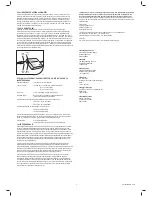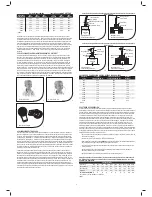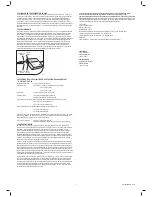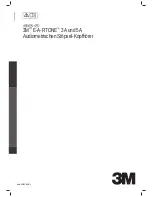
3
Octave Band
125 -
250 -
500 -
125 -
250 -
500 -
Intervals
8,000 Hz
8,000 Hz
8,000 Hz
8,000 Hz
8,000 Hz
8,000 Hz
125
35.0 39.0 49.0
59.0 67.0 78.0
250
25.0 25.0 35.0
53.0 53.0 64.0
500
21.0 21.0 21.0
50.0 50.0 50.0
1000 26.0 26.0 26.0
47.0 47.0 47.0
2000 34.0 34.0 34.0
49.0 49.0 49.0
4000 37.0 37.0 37.0
50.0 50.0 50.0
8000 37.0 37.0 37.0
56.0 56.0 56.0
Table 2.
SUPRA-AURAL EARPHONE
E-A-RTONE FULL INSERTION
Frequency
Coupler 2cc DB-0138
Coupler IEC 711
Coupler 2cc
in Hz
(HA-2)
Occluded Ear Simulator
(HA-1)
125
96.0
98.0
96.5
250
84.0
87.5
84.5
500
75.5
79.5
76.0
750
72.0
76.0
72.0
1000
70.0
75.5
70.0
1500
72.0
79.5
70.0
2000
73.0
81.5
72.5
3000
73.5
83.0
72.5
4000
75.5
85.0
70.0
6000
72.0
86.0
67.5
8000
70.0
85.5
66.5
Table 3.
ANSI S3.6-2004 AND ISO 389-2:1994 CALIBRATION VALUES
The ears covered MPANLs shown above in Table 2. were derived using mean earphone attenuation
values. To decrease the chance that individual listeners for whom less than average attenuation is
obtained will experience threshold shift, the MPANLs can be lowered by reducing the predicted level
of earphone attenuation. An appropriate reduction would be equal to the mean attenuation minus
one standard deviation. The net effect would be that the MPANLs would be lower (more stringent)
for ears covered testing. This reduction would cover approximately 84% of all subjects. The standard
deviations for Insert Earphones for 125 to 8000 Hz are between three (3) and six (6) decibels.
Please refer to ANSI S3.1 – 1999, Table A.2, for specifi c standard deviation values by frequency.
3. POSITIONING OF THE E-A-RTONE™ INSERT EARPHONE
When positioning the E-A-RTONE™ 3A Insert Earphone on a test subject, avoid sound tube
contact with the subject’s clothing. The supplied Velcro-backed clips (Figure 7.) can be used to
attach each of the E-A-RTONE™ 3A Insert Earphone transducer cases directly to the test subject’s
clothing, or they can be used in conjunction with the supplied neck loop as illustrated in Figure 5.
Although the shape of the E-A-RTONE™ 5A Insert Earphone case is similar to that of a small BTE
instrument, correct insertion of the connected E-A-RLINK™ foam eartip will suspend the red and
blue transducer cases in front of the pinna, as illustrated in Figure 6. The junction or pod portion of
the E-A-RTONE™ 5A Insert Earphone cable assembly can be supported at or near the patient’s mid
chest level by attaching a single Velcro-backed clip to the pod portion of the cable and then either
directly clipping it to the subject’s clothing or to the metal ring on the lanyard that is worn around
the neck. The spring-loaded bead on the lanyard will allow its length to be adjusted as necessary.
Always use E-A-RLINK™ tips in both ears, or block the non-test ear with an E-A-R™ Classic™
foam earplug.
4. PURE TONE CALIBRATION
When the E-A-RTONE™ Insert Earphone is to be used as the primary transducer, the audiometer
should be re-calibrated using the reference thresholds specifi ed in ANSI S3.6-2004, or its revisions.
The Standard provides reference thresholds for the HA-2 coupler (Figure 8. and Figure 10. for the
E-A-RTONE 3A and E-A-RTONE 5A models, respectively), the HA-1 coupler (Figure 9. and Figure
11. for the E-A-RTONE 3A and E-A-RTONE 5A models, respectively), and for the “Occluded Ear
Simulator” coupler (not illustrated). The Bruel & Kjaer 2cc DB-0138 (HA-2) coupler will simplify the
calibration procedure for both insert earphone models, and is recommended. Calibration values
for the three acoustic couplers are provided below in Table 3. (from ANSI S3.6-2004). Should
calibration be performed for an audiometer currently calibrated towards ISO-389, the reference
thresholds in a 2cc DB-0138 coupler should be used.
In order to calibrate the audiometer for direct readings of the hearing thresholds in dBHL using
the reference thresholds, the following procedure is recommended. The instrumentation required
includes a Sound Level Meter with octave-band fi lter capability and an appropriate condenser
microphone, calibrated according to the manufacturer’s specifi cation. A 2cc coupler, e.g., Bruel &
Kjaer DB-0138 is attached to the microphone. The white nylon tube nipple of the E A RTONE™
3A Insert Earphone, or the stainless steel case nipple of the E A RTONE™ 5A Insert Earphone,
is connected directly to the coupler (see illustrations) via a small section of #13 hearing aid tubing.
Set the intensity dial on the audiometer to 70 dBHL and adjust the output from the audiometer to the
Sound Pressure Level (SPL) values given for each of the test frequencies in Table 3. below. Repeat
the procedure for all available test frequencies, and in case of a dual channel audiometer, for both
channels.
5. CORRECTION FACTORS
Measured correction factors may be used where it is necessary to switch between insert and
supra-aural earphones. If the audiometer is calibrated for either type of transducer as the primary
earphone, measured correction factors for a secondary earphone can be obtained without adjusting
the audiometer calibration by measuring the output of the secondary earphone on the appropriate
coupler and calculating the difference from the appropriate target value at each frequency.
Audiogram correction factors can then be confi dently applied for testing with the secondary
earphone. The outlined procedure below is followed by an example worksheet (Table 4.) for the
calculation of correction factors by frequency where, in this example, the audiometer is calibrated
for a supra-aural earphone, and an insert earphone will be used as the secondary transducer.
The measured SPLs are the 2cc coupler values obtained with an insert earphone connected to
an audiometer calibrated for a supra-aural earphone, and the Target SPLs are the audiometer HL
setting plus the insert earphone RETSPLs for the particular 2cc coupler used. The process will work
as well in reverse, i.e. with an audiometer calibrated for an E-A-RTONE™ Insert Earphone with a
supra-aural earphone desired as the secondary transducer, as long as the appropriate Target SPLs
(TDH/supra-aural earphone values) are employed.
• If necessary, calibrate the audiometer to the appropriate standard with/for the primary
transducer. (TDH-39, 49 or 50 in this example)
• Connect the E-A-RTONE™ Insert Earphone to the audiometer.
• Measure the output by frequency in a 2cc coupler and enter (substitute) the obtained values for
the Measured SPLs in the example worksheet below.
• Tabulate at each test frequency the difference between actual and target sound pressure levels.
• Apply the rounded correction factors obtained to the audiometer dial readings. Record and post
for convenience.
• Repeat the procedure whenever the audiometer is calibrated with the primary transducer.
Case nipple/coupler connection for E-A-RTONE™3A insert earphone calibration
Case nipple/coupler connection for E-A-RTONE™5A insert earphone calibration
Frequency in Hz
Worksheet example for calculation of individual E-A-RTONE Insert Earphone correction factors
for an audiometer calibrated with a TDH type (supra-aural) earphone.
“Measured SPLs” are hypothetical.
Frequency
250 500 750 1000 1500 2000 3000 4000 6000 8000
Measured
SPLs
90.5 76.8 74.1 72.0 73.4 77.5 79.3 76.5 63.7 58.0
Target
SPLs*
84.0 75.5 72.0 70.0 72.0 73.0 73.5 75.5 72.0 70.0
Difference
6.5 1.3 2.1 2.0 1.4 4.5 5.8 1.0 -8.3
-12.0
Rounded
Correction
5 0 0 0 0 5 5 0 -10
-10
* Target SPLs = audiometer HL + RETSPL
Table 4.
11
10
Velcro clips
5
6
7
8
9
HA-2 coupler
calibration connection
HA-1 coupler
calibration connection
HA-2 coupler
calibration connection
HA-1 coupler
calibration connection
E-A-RTONE sound tube
Sound tube nipple
DB-0138 nipple
#13 tubing
DB-0138
2cc
coupler
E-A-RTONE sound tube
E-A-RLINK
FUNTAK
HA-1 coupler
E-A-RTONE
Case
E-A-RLINK
FUNTAK
HA-1 COUPLER
DB-0138
2cc
coupler
E-A-RTONE
Case
#13 tubing
Case nipple
DB-0138 nipple
E-A-RTONE™ 3A
E-A-RTONE™ 5A
Summary of Contents for E-A-RTONE 3A
Page 1: ...34 8708 1478 6 www 3M EU Safety 3M E A RTONE 3A and 5A Audiometric Insert Earphones GZXO ...
Page 9: ...34 8708 1478 6 www 3M EU Safety 3M E A RTONE 3A et 5A Écouteurs internes pour audiométrie FzB ...
Page 17: ...34 8708 1478 6 www 3M EU Safety 3M E A RTONE 3A und 5A Audiometrischen Stöpsel Kopfhörer Dza ...




































